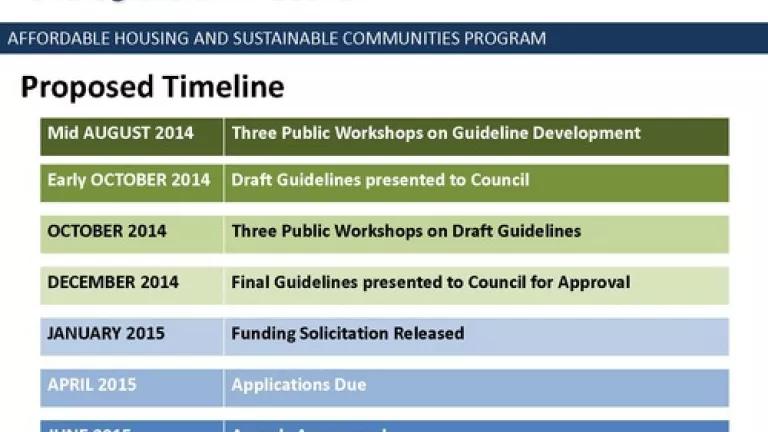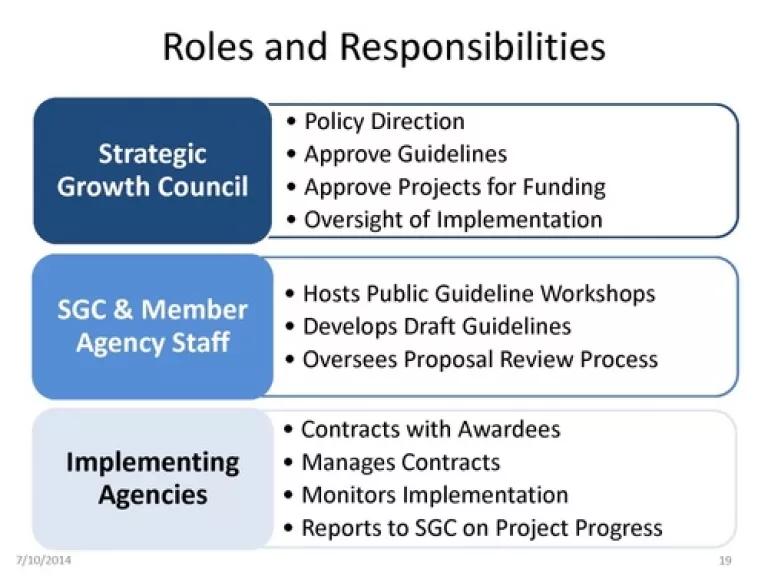Strategic Growth Council affirms its role as lead agency implementing cap and trade revenues for sustainable communities

“We definitely know both in statute and because of agreement among the Council that the Council will retain all important authority over this program and all responsibility for the success of this program.” – Mike McCoy, Executive Director of Strategic Growth Council, July 10, 2014
From the standing room only turnout at last week’s Strategic Growth Council (SGC) meeting, you would never have guessed we were smack in the middle of summer vacation season. The meeting was convened to discuss the new Affordable Housing and Sustainable Communities Program (AHSC), a recently designated recipient of some of the proceeds from California’s cap and trade program.
Supporters of California’s landmark sustainable communities and climate law SB 375 cheered this new program, as it represents the first permanent source of funding for implementing the Sustainable Communities Strategies that regions around the state have developed to reduce their greenhouse gas emissions under SB 375. The AHSC program received $130 million of cap and trade proceeds in the 2014 fiscal year, and 20% of all cap and trade revenues in following years (total estimated at several billion per year). Eligible uses of the AHSC funds include: affordable housing and transit-oriented development, transit, active transportation, complete streets, farmland conservation, planning to implement Sustainable Communities Strategies, and other programs and projects designed to limit greenhouse gas emissions by reducing car travel.
With an aggressive timeline to deploy funds, the Council is already starting to act.
In advance of the hearing, responding to some concerns about the Council’s proposed action to delegate implementation authority of the AHSC program, Senate President pro Tem and author of SB 375, Darrell Steinberg, sent a letter to Council Chairman Ken Alex. This letter makes clear that:
1) the Council should lead on ranking projects and distributing funds;
2) regional agencies charged with implementing SB 375 should play an active role in selecting the best projects for their regions;
3) the fund guidelines should be reexamined and open to revision after this first push to deploy funds; and,
4) the focus should be on GHG reductions.
During the Council meeting, good discussion clarified the Staff’s recommended action and provided greater specificity to the roles of the Council and supportive state agencies. An amendment to the Council’s action was made, clarifying that the Council will retain authority and coordinate the technical and administrative support from the Department of Housing and Community Development (HCD), the CA Natural Resources Agency, and the CA Department of Conservation (referred to in the chart below as “implementing agencies”). Council discussion—though no amendments to the motion—also affirmed their agreement with Steinberg’s other key points, namely 1) the MPOs will be key partners in fund distribution, 2) the Council fully expects to revisit these guidelines and implementation decisions after the first round, and 3) the mandate to reduce GHG emissions through this program is abundantly clear and was several times reinforced.
Councilmember Laird explained the collaborative effort under the Council’s leadership: “We’re reserving all the high-level decisions here. They are not being surrendered in every way, but for the expertise that our staff doesn’t have, or the capacity, or the breadth--that’s where you’re doing it [pointing to a HCD representative] within the overall direction or approval of the Strategic Growth Council.” The chart below presented by Council staff illustrates this point:

We are pleased to see the Council commit to a thorough public outreach process to develop the guidelines this summer. We had initially reacted that any decisions about which agency should be charged with implementing this program should follow rather than precede the public outreach process, but we are sympathetic to the goals of getting the funding out the door to communities expeditiously.
The breadth of possible projects, potential for innovation, and guarantee of greenhouse gas emissions reductions within this program is tremendous. We look forward to working closely with the Council, HCD, the Natural Resources Agency, the Dept. of Conservation, stakeholders, and other supportive agencies as they develop fund guidelines for this first round of cap and trade dollars and get money flowing quickly towards the best projects.
